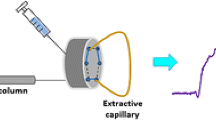Summary
Improvements in selectivity and sensitivity in the analysis of common explosives, like nitrate esters, nitramines and nitroaromatic compounds can be achieved by post-column derivatisation in a two step reaction detector. The first step in derivatisation is the photolysis of the analytes with UV at 254 nm. The photo reactor consists of a crocheted 20 m Tefzel capillary, which is coiled around a low pressure mercury lamp. In second step the nitrite ion generated is subsequently detected by a colourimetric reaction. The azo dye formed can be selectively detected at 540 nm.
Addition of alkali after chromatographic separation to prevent oxidation of initially formed nitrite to nitrate during photolysis leads to a complex multistage arrangement. However, the contribution to peak broadening by the reactor is negligible and it is possible to detect 25–50 ppb of nitramines and 30–100 ppb of nitrate esters. Another advantage of the method is the selective detection of nitro compounds, even in complex matrices.
The trace analysis of explosives is of growing interest in forensic science as well as in environmental analysis. It has been shown [1] that explosives can easily be extracted from soil and debris by the use of supercritical carbon dioxide. The separation and determination of explosives by gas chromatography is hindered by their thermal instability. In HPLC only the nitro aromatic explosives can be detected with sufficient sensitivity. Other types of explosives like the esters of nitric acid or nitramines do not absorb sufficiently in the UV region for sensitive detection. It has been shown [2] that explosives are liable to photochemical decomposition in the UV region, resulting in nitrate and nitrite, which have been detected after separation by ion-pair chromatography with electrochemical detection. A more sensitive and selective detection of nitrite has been possible in flow injection analysis [3]. Here a modified Griess reaction has been used. In a first step nitrite ions are used to form the diazonium salt with sulfanilamide which is coupled in a second step with N-[naphthyl-(1)]-ethylene diamine (NED) to form a redviolet azo dye with an absorption maximum at 540 nm. The advantage of this method is selective detection in the visible region, where hardly any other organic components are detected, which might be present in a crude environmental sample.
In this paper the transfer of the Griess reaction to post-column derivatisation in RP chromatography of explosives will be described, and the optimisation of trace analysis of these solutes will be discussed.
Similar content being viewed by others
References
H. Engelhardt, J. Zapp, P. Kolla, Chromatographia32, 527 (1991).
M. Lookabough, I. S. Krull, J. Chrom.452 (1988) 295–308.
H. Engelhardt, G. Schöndorf, Fresenius Z. Anal. Chem.,333 (1989) 719.
H. Engelhardt, U. D. Neuer, Chromatographia15 (1982) 403.
H. Engelhardt, R. Klinkner, Fresenius Z. Anal. Chem.,317 (1984) 687.
H. Engelhardt, B. Lillig, Fundamentals of Reaction Detection Systems in:Krull, ed., Reaction Detection in Liquid Chromatography, Chromatogr. Sci. Series, Vol. 34, M. Dekker, New York 1986, p. 1–61.
H. Engelhardt, B. Lillig, HRC & CC8, 531 (1985).
I. Wagner, H. Strehlow, G. Busse, Z. Phys. Lett.3 (1969) 611.
I. Wagner, H. Strehlow, Z. Phys. Chem. (Frankfurt/Main)132 (1982) 151.
I. Wagner, H. Strehlow, G. Busse, Z. Phys. Chem. Neue Folge123 (1980) 1.
Author information
Authors and Affiliations
Rights and permissions
About this article
Cite this article
Engelhardt, H., Meister, J. & Kolla, P. Optimisation of post-column reaction detector for HPLC of explosives. Chromatographia 35, 5–12 (1993). https://doi.org/10.1007/BF02278550
Received:
Accepted:
Issue Date:
DOI: https://doi.org/10.1007/BF02278550




